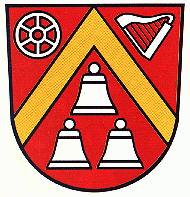Hundeshagen: Difference between revisions
Knorrepoes (talk | contribs) m (Text replacement - "/Arms of " to "/Arms (crest) of ") |
Knorrepoes (talk | contribs) m (Text replacement - "{{media}}" to " {{de1}} {{media1}}") |
||
| Line 29: | Line 29: | ||
The wheel in the upper part symbolises the fact that the village historically belonged to the [[State of Mainz]]. | The wheel in the upper part symbolises the fact that the village historically belonged to the [[State of Mainz]]. | ||
{{ | |||
{{de1}} | |||
{{media1}} | |||
[[Civic Heraldry Literature - Germany|'''Literature''']]: Ulle, 1997. | [[Civic Heraldry Literature - Germany|'''Literature''']]: Ulle, 1997. | ||
Revision as of 12:21, 26 December 2022
This page is part of the German heraldry portal Deutsche Wappensammlung |
Heraldry of the World |
|
German heraldry:
|
Selected collector's items from Germany:
|
HUNDESHAGEN
State : Thüringen
District (Kreis) : Eichsfeld
Incorporated into : 2018 Leinefelde-Worbis
| German |
Auf rotem Grund ein goldener Sparren, rechts begleitet von einem sechsspeichigen Rad, links begleitet von einer silbernen Harfe, im Winkel drei silberne Glocken. |
| English | No blazon/translation known. Please click here to send your (heraldic !) blazon or translation |
Origin/meaning
The arms were granted on December 15, 1992.
The village was historically known as a village of musicians, especially harp players. This is symbolised by the harp in the arms.
A typical construction in the village is the local bell tower with three large bells. This is symbolised by the golden chevron and the three bells.
The wheel in the upper part symbolises the fact that the village historically belonged to the State of Mainz.
Literature: Ulle, 1997.


